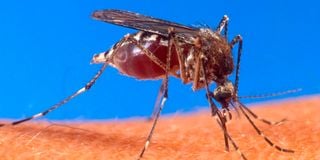Strategy to fight new malaria threat unveiled

The World Health Organization (WHO) has announced a new initiative to stop the spread in Africa of a malaria-causing mosquito species originally from Asia.
What you need to know:
- WHO has announced a new initiative to stop the spread in Africa of a malaria-causing mosquito species originally from Asia.
- According to the global health regulator, Anopheles stephensi (An. stephensi), native to parts of South Asia and the Arabian Peninsula, is an invasive mosquito species identified as being a “significant threat” to malaria control and elimination in Africa.
- Experts say the species has increased its range over the past decade and is now present in Djibouti, Ethiopia, Sudan, Somalia and Nigeria.
The World Health Organization (WHO) has announced a new initiative to stop the spread in Africa of a malaria-causing mosquito species originally from Asia.
According to the global health regulator, Anopheles stephensi (An. stephensi), native to parts of South Asia and the Arabian Peninsula, is an invasive mosquito species identified as being a “significant threat” to malaria control and elimination in Africa.
Experts say the species has increased its range over the past decade and is now present in Djibouti, Ethiopia, Sudan, Somalia and Nigeria.
According to WHO, the new initiative aims to support an effective regional response to An. stephensi on the African continent through a five-pronged approach that includes increasing collaboration across sectors and borders, and strengthening surveillance to determine the extent of the spread of the species and its role in transmission.
The strategy also involves improving information exchange on the presence of A. stephensi and efforts to control it, developing guidance for national malaria control programmes on appropriate ways to respond to the vector, and prioritising research to evaluate the impact of interventions and tools.
WHO further recommends that, where feasible, national responses to An. stephensi should be integrated with efforts to control malaria and other vector-borne diseases such as dengue fever, yellow fever, and chikungunya.
Unlike the other main mosquito vectors of malaria in Africa, experts say An. stephensi thrives in urban settings, raising concerns about the impact it could have on the control and elimination of malaria in the region since more than 40 per cent of the population in Africa lives in urban areas.
“We are still learning about the presence of An. stephensi and its role in malaria transmission in Africa,” Dr Jan Kolaczinski, who leads the Vector Control and Insecticide Resistance unit at the WHO Global Malaria Programme said.
“It is important to underscore that we still don’t know how far the mosquito species has already spread and how much of a problem it is or could be,” she added.
Integrated action
According to Dr Ebenezer Baba, a malaria adviser to the WHO African Region, more action is needed.
“Integrated action will be key to success against An. stephensi and other disease vectors. Shifting our focus to integrated and locally adapted vector control can save both money and lives,” he said.
Kenya has been steadily expanding its anti-malaria campaign over the years.
In April this year, the Ministry of Health announced that it had dispatched 10 Cuban experts to Kakamega, Siaya, Kisumu, Bungoma, Busia, Vihiga, Homa Bay and Migori counties who will use biological methods to control mosquito breeding.
In June last year, while on a three-week tour of Cuba, outgoing Health Cabinet Secretary Mutahi Kagwe and Cuban Public Health Minister Jose Angel Portal Miranda signed a deal that would see 101 health specialists work in the country under the two-year larvicide programme.
Dr George Githuka, the head of the National Malaria Control Programme, said the experts would start working between May and June this year.
“The experts are here and the project is ongoing. We have procured biolarvicides and have already done all the preparatory activities, including talking to communities,” Dr Githuka said then.
According to the National Library of Medicine, biolarvicides are highly effective against mosquito larvae at very low doses and safe for other non-target organisms.
But larvicide is an expensive process that requires the engagement of many specialists and local volunteers to execute, experts say.
The larvicide initiative is part of a medical exchange programme between Kenya and Cuba that saw more than 50 Kenyan doctors sent to study in Cuba. They have since returned and been deployed to various hospitals around the country.
WHO, in a report, has cautioned against larvicide to control malaria in sub-Saharan Africa. It explained that the chemicals should be used “only in areas where the breeding sites are few, fixed and findable”, which is rare in Africa.
Read: Step up war on malaria
The global health regulator is of the view that there are other more cost-effective ways of fighting malaria. However, according to the outgoing Chief Administrative Secretary in the Ministry of Health Rashid Aman, Cuba eliminated malaria in 1973 mainly through larvicides.
“Cuban experts have been deployed to all the eight endemic counties and will work with our health teams for two years within which they will transfer their skills to our malaria control experts,” he said.





